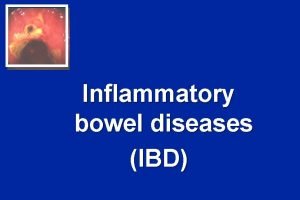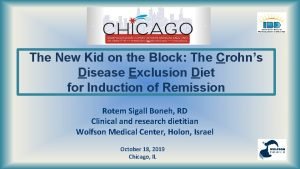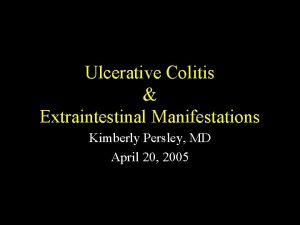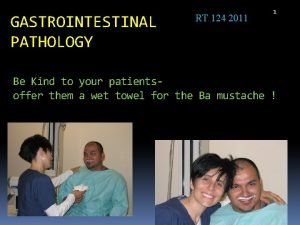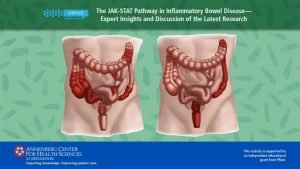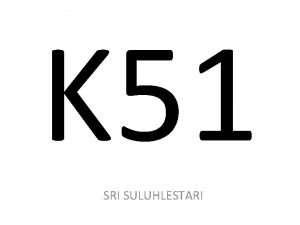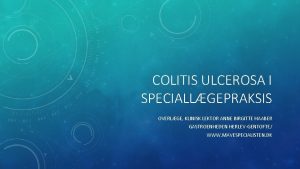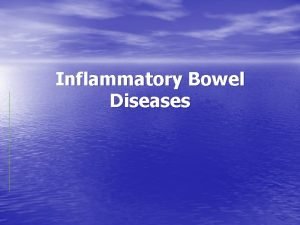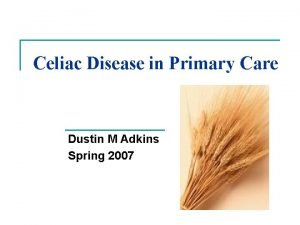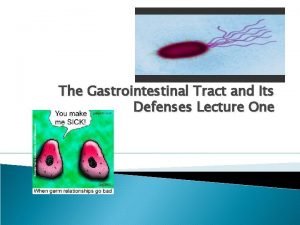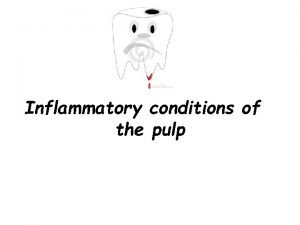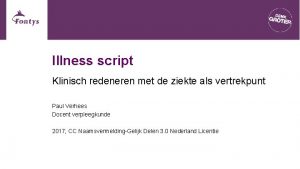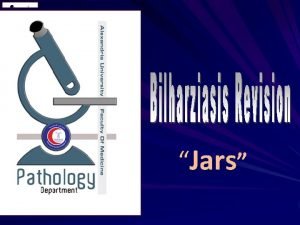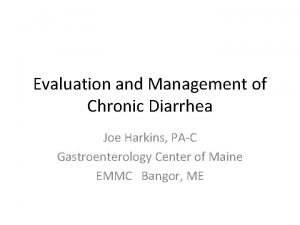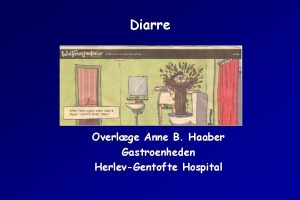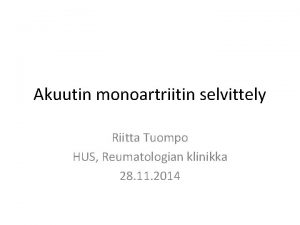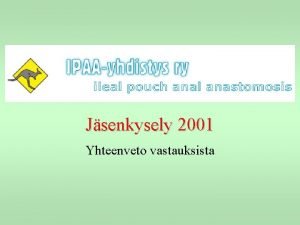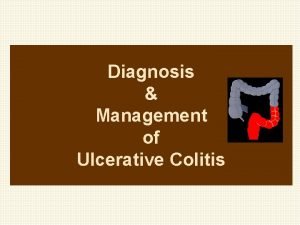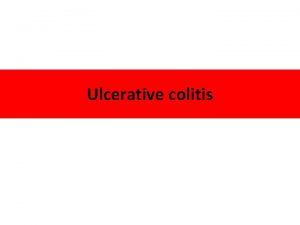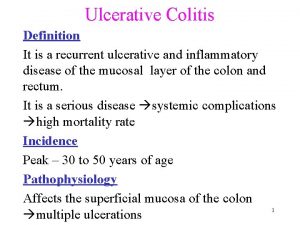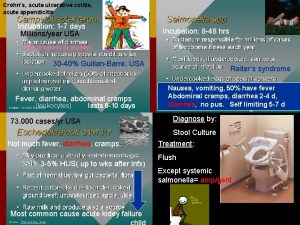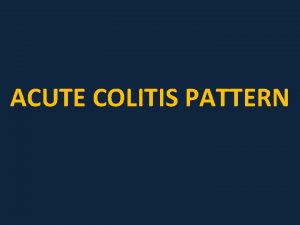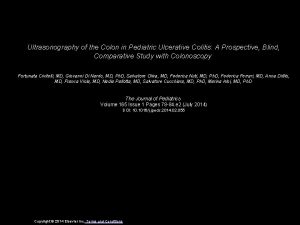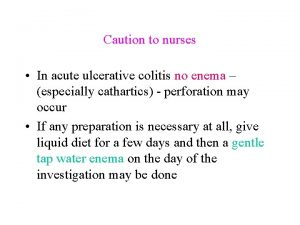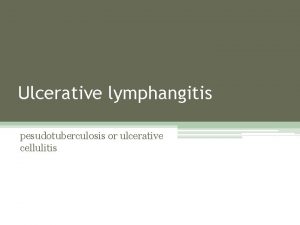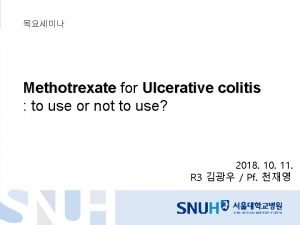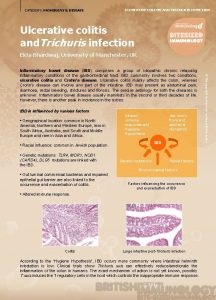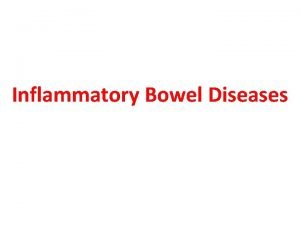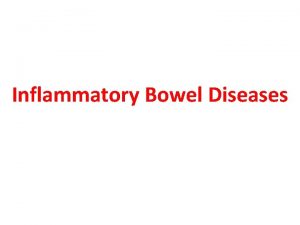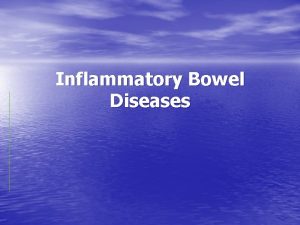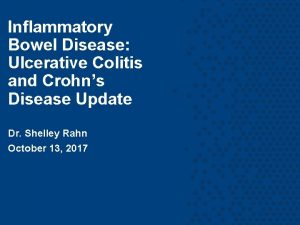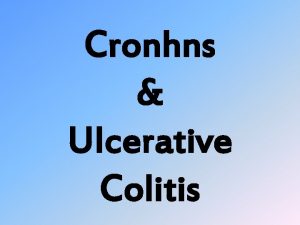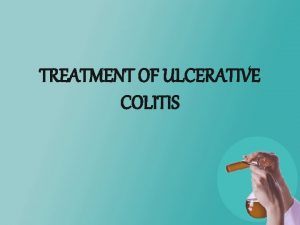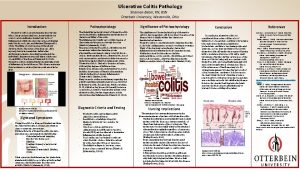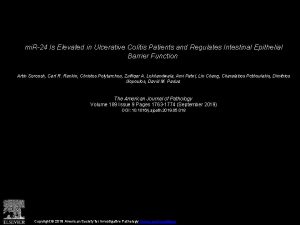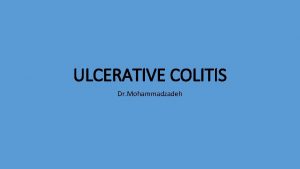Acute Pediatric Ulcerative Colitis Lessons from the OSCI









































- Slides: 41

Acute Pediatric Ulcerative Colitis: Lessons from the OSCI Trial James Markowitz, MD Professor of Pediatrics Hofstra – North Shore LIJ School of Medicine Department of Pediatrics Cohen Children’s Medical Center of NY New Hyde Park, NY

Disclosures I have the following financial relationships : l Janssen Biotech: research support, consultant l UCB: consultant l Abbvie: consultant

What is acute severe colitis?

Acute Severe Colitis in Adults (European Crohn’s and Colitis Organization, 2008) l At least six bloody stools per day and at least one of the following: Tachycardia ( > 90 b. p. m. ) l Temperature > 37. 8 ° C l Anemia (hemoglobin < 10. 5 g/ dl) l Elevated ESR ( > 30 mm/ h) l Travis SPL, et al. J Crohn Colitis 2008; 2 : 24 -62

Pediatric UC Activity Index (PUCAI) ITEM POINTS 1. Abdominal pain: No pain Pain can be ignored Pain cannot be ignored 0 5 10 0 -2 3 -5 6 -8 >8 0 10 5. Nocturnal stools (any episode causing wakening) 20 No Yes 30 6. Activity level 3. Stool consistency of most stools Formed Partially formed Completely unformed POINTS 4. Number of stools per 24 hours 2. Rectal bleeding None Small amount only, in <50% of stools Small amount with most stools Large amount (>50% of the stool content) ITEM 0 5 10 No limitation of activity Occasional limitation of activity Severe restricted activity SUM OF PUCAI (0 -85) Turner D, et al. Gastroenterology 2007; 133: 423 -32. 0 5 10 15 0 10 0 5 10

PUCAI cutoffs (n=205) r=0. 91 Definition P<0. 001 PUCAI score n=25 n=57 n=42 n=81 None Mild Moderate Turner D et al; Gastroenterology 2007; 133: 423 -432 Severe AUC of ROC Sens/Spec Severe: >65 0. 97 (0. 950. 99) 96%/ 91% Mod: 35 -60 0. 97 (0. 950. 99) 96%/ 91% Mild: 10 -30 0. 98 (0. 970. 99) 89%/ 94% None: <10 0. 99 (0. 99 -1) 95%/ 99%

How common is acute severe colitis?

Acute Severe Colitis: Frequency l Adults: 18 -25% of patients over 10 years Edwards FC, Truelove SC. Gut. 1963 Dec; 4: 299 -315. Dinesen LC, et al. J Crohn Colitis. 2010 Oct; 4(4): 431 -7. Epub 2010 Feb 19. l Children: l Retrospective review of admissions to Hospital for Sick Children in Toronto (1991 -1996) l “Population based” sample estimate (only children with addresses from the Greater Toronto area) l 55/196 (28%) of children with UC <15 yrs of age admitted for IV corticosteroids Turner D, et al. Gut. 2008 Mar; 57(3): 331 -8.

Natural History of UC: Looking back the picture was not pretty Author Year Study cohort Outcome Hardy 1 1933 95 adults 75% mortality at 1 year Truelove/Witts 2 1955 Adult UC treated with HC 6% HC and 15% control pts died within 6 months Goel 3 1973 25 hospitalized children with UC 20% died (post-colectomy), 19 had chronic disease Michener 4 1979 336 children 35% colectomy, 5% died (cancer); 69% chronically ill Langholz 5 1994 1161 adults 30% colectomy by 15 years 1 BMJ 1933; 2: 812; 2 BMJ 1955; 4947: 1041; 3 Arch Dis Child 1973; 48: 337; 4 J Clin Gastroenterol 1979; 1: 301; 5 Gastroenterology 1994; 107: 3

Cumulative Probability of Colectomy In Children with UC (1975 -1995) Colectomy Rate (N=171) Mild vs moderate/severe, P<0. 03 1 Yr 5% (2%, 9%) 5 Yr 19% (12%, 25%) Hyams JS et al. J Pediatr. 1996; 129: 81.

Cumulative Probability of Colectomy in Children with UC (1975 -1995) Cumulative Probability 0. 4 Moderate/Severe (n=98) 26% Mild (n=73) 0. 3 Colectomy Rate 0. 2 9% (N=171) 5% (2%, 9%) 19% 5 Yr (12%, 25%) 1 Yr 0. 1 0. 0 0 1 2 3 4 5 6 7 Years From Diagnosis Mild vs moderate/severe, P<0. 03 Hyams JS et al. J Pediatr. 1996; 129: 81.

How might we change the outcome of children with acute severe colitis?

Severe/Fulminant Ulcerative Colitis 16 year old presents with 10 bloody stools per day, Hb 9, unresponsive to oral corticosteroids

What is the OSCI Trial? OSCI = Outcome of Steroid therapy in Colitis Individuals

How effective are intravenous corticosteroids for acute severe UC?

IV Corticosteroids for Acute Severe UC Toronto 1991 -2000 (retrospective) Study population N=99 IV Steroid Failure N=46 (46%) IV Steroid Success N=53 (53%) Short term: 53% avoid colectomy &/or rescue therapy 1 Year: 18% steroid free without colectomy &/or rescue therapy Turner D et al. Gut 2008; 57: 331 -338 OSCI 2008 -2009 (prospective) Study population N=128 IV Steroid Failure N=37 (29%) IV Steroid Success N=91 (71%) Short term: 71% avoid colectomy &/or rescue therapy 1 Year: 59% steroid free without colectomy &/or rescue therapy Turner D et al Gastro 2010; 138(7): 2282 -91

What factors predict likely response to intravenous corticosteroids (IVCS)?

Predictors of IV Corticosteroid Response on Day 0: OSCI Trial IV Steroid Success (n=91) Age at Rx (yrs)* 12. 2 ± 4. 1 IV Steroid Failure (n=37) 14. 4 ± 3. 2 % male 44% 54% + Fam Hx IBD 12% First UC attack* 56% 30% Months from Dx 12. 4 (5 -38) 11 (4 -19. 6) PUCAI score on admission 71 ± 12 74 ± 11 Turner D et al Gastro 2010; 138(7): 2282 -91

How long should we wait for intravenous corticosteroids to be effective?

2003 Peds GI Symposium Audience Response

Duration of Initial Therapy • Recommendations vary, depends upon absence of absolute indications for surgery • If you wait too long complications will occur – 7 days 1, 2 – 10 to 14 days 3, 4 – >14 days is acceptable 5 • Treatment for 15 to 36 days • 1 patient to surgery, perforation, 11 units packed RBC 1 Truelove 4 Meyers S. J Clin Gastroenterol. 1990 Aug; 12(4): 479 -80 SC et al. Lancet. 1974; 1: 1067. 2 Goligher JC et al. Br Med J. 1970 Dec 19; 4(737): 703 -6. 5 Gold et al. Am J Gastroenterol. 1995 May; 90(5): 732 -5. 3 Werlin SL et al. Gastroenterology. 1977; 73: 828.

Predicting IV Corticosteroid Failure and Need for Rescue Therapy l l Day 3: PUCAI >45 (moderate) – start planning Day 5: PUCAI >70 (severe) – time for 2 nd line Rx Sensitivity (95% CI) Specificity NPV PPV Odds ratio Day 3 92% (72 - 98) 50% (44 - 52) 94% (84 - 98) 43% (37 - 45) 11. 1 (3 - 49); P<0. 0001 Turner D et al Gastro 2010; 138(7): 2282 -91 Day 5 35% (23 - 36) 100% (94 - 100) 79% (68 - 97) 100% (65 - 100) 64 (5 - >1000); P<0. 0001

Time to 2 nd Line Therapy Stratified by PUCAI on Day 3 and Day 5 Turner D et al Gastro 2010; 138(7): 2282 -91

What therapy is best when iv corticosteroids fail? Calcineurin inhibitors (cyclosporine, tacrolimus) vs Anti-TNF (infliximab)

Tacrolimus in Peds UC UCLA l l 18 patients Retrospective, open-label l 9 steroid resistant UC Acute response: 8/9 (89%) Colectomy by 1 yr: 6/9 (67%) Ziring at al. JPGN 2007; 45(3): 306 -311. Multicenter 14 patients l Prospective, open-label l 10 UC, 2 CD, 2 IC l Minimum 7 days of severe colitis despite CS l Acute response: 13/14 (93%) l Colectomy by 1 yr: 8/13 (62%) l Bousvaros A et al. J Pediatr. 2000; 137: 794

Tacrolimus Pediatric Experience (Boston Children’s) l 46 children, retrospective, open-label l l All steroid refractory UC 43/46 (93%) acute response l 60% colectomy at 26 months Watson S et al. Inflamm Bowel Dis. 2011 Jan; 17(1): 22 -9. Epub 2010 Aug 18

Infliximab Induction in Chronic Active UC Open label induction with 5 mg/kg infliximab at 0, 2, 6 weeks Treatment outcome assessed at 8 weeks Pediatric trial Adult trials Hyams J et al. Clin Gastroenterol Hepatol 2012; 10(4): 391 -9 Rutgeerts P, at al. N Engl J Med 2005; 353: 2462 -76

Infliximab in Acute Severe Colitis l Swedish double-blind placebo controlled adult UC trial l 24 infliximab, 21 placebo l 3 month colectomy rates l Infliximab: 7/24 (29%) l Placebo: 14/21 (67%) (P =. 017; odds ratio, 4. 9; 95% confidence interval, 1. 4 -17) Jarnerot G, et al. Gastroenterol. 2005 Jun; 128(7): 1805 -11

2 nd Line Rx for Acute Severe UC: Infliximab OSCI 2008 -2009 (prospective) Study population N=128 IV Steroid Failure N=37 (29%) IV Steroid Success N=91 (71%) Short Term Response to Infliximab: 25/33 + 5/7 = 30/40 (75%) avoid imminent colectomy Response at 1 Year 18/33 + 5/7 = 23/40 (58%) avoid colectomy Infliximab N=33 Cyclosporine N=1 Colectomy N=3 Acute Outcome Response N = 25 Colectomy N = 8 Outcome at 1 Year Colectomy N = 7 Turner D et al Gastro 2010; 138(7): 2282 -91 Infliximab N=7 Colectomy N=3 Outcome at 1 Year Response N = 5 Colectomy N = 2

Colectomy Following Rescue Therapy for IVCS Resistant Acute Severe Colitis Turner D et al Gastro 2010; 138(7): 2282 -91 Turner D et al. Gut 2008; 57: 331 -338 Ziring at al. JPGN 2007; 45(3): 306 -311 Bousvaros A et al. J Pediatr. 2000; 137: 794 Watson S et al. IBD 2011; 17(1): 22 -9

Colectomy Following Rescue Therapy for IVCS Resistant Acute Severe Colitis Turner D et al Gastro 2010; 138(7): 2282 -91 Turner D et al. Gut 2008; 57: 331 -338 Ziring at al. JPGN 2007; 45(3): 306 -311 Bousvaros A et al. J Pediatr. 2000; 137: 794 Watson S et al. IBD 2011; 17(1): 22 -9

Cyclosporine vs Infliximab in Acute Severe UC: A parallel, open-label randomised controlled adult trial l Patients (N=115) l l l Severe, acute UC IV steroid resistant Treatments l l l IV Cs. A (2 mg/kg/d x 1 week, then po x 98 days) IFX (5 mg/kg at 0 -2 -6 wks) In patients with a clinical response at week 7, azathioprine initiated and steroids decreased Cs. A N=58 IFX N=57 Treatment failure 60% 54% Day 7 response 84% 86% Day 98 colectomy (n) 10 13 SAE (n) 10 16 Laharie D et al. Lancet 2012; 380: 1909– 15

Why are today’s outcomes following iv steroids better than in the past? What else can we do to decrease colectomy rates further? Remember to look for: C. Difficile CMV

C difficile Complicating IBD l C diff prevalence in hospitalized children l IBD (24. 7%) vs non-IBD controls (8. 9%) OR 3. 3 (95%CI 1. 5 to 7. 6) Pascarella F, et al. J Pediatr. 2009 Jun; 154(6): 854 -8 l Compared to adults with either condition alone, those with both C diff and IBD have l lengthier hospitalizations l fourfold increased mortality Ananthakrishnan AN, Mc. Ginley EL, Binion DG. Gut. 2008 Feb; 57(2): 205 -10

C difficile and IBD l Diagnosis Immunoassays or ELISAs for toxin A and toxin B l Cytotoxicity assay l PCR l l Diagnostic accuracy l One toxin assay fails to identify most infections l Toxin A assay missed 41. 5% of infections l Toxin B assay missed 34. 9% of infections Markowitz JE, et al. Am J Gastroenterol. 2001 Sep; 96(9): 2688 -90

C difficile Can be Difficult to Diagnose in IBD Despite Assay for Both Toxin A and B Issa M, et al. Clin Gastroenterol Hepatol. 2007 Mar; 5(3): 345 -51

CMV Complicating UC l CMV disease = CMV in tissue l l l Patient characteristics l l Seropositive; Immunosuppressed rihes. cmu. ac. th Effects: steroid resistance l l Sigmoidoscopy and Bx Immunohistochemistry better than light micro 5 -36% of CS resistant UC vs 0 -10% with CS sensitive UC Rx: Gangcyclovir, ? d/c immune suppression Dommenech E, et al. Inflamm Bowel Dis 2008; 14: 1373– 1379 markwickmd. com


Lessons of the OSCI Study l Acute severe colitis continues to present significant clinical challenges l l Colectomy: 9% acutely, 19% at 1 year Use PUCAI to judge severity of disease and response to therapy l PUCAI >45 on Day 3 → plan rescue Rx …(flex sig for CMV) l PUCAI ≥ 70 on Day 5 → time for 2 nd line treatment

l Both infliximab and calcineurin inhibitors Can induce remission in ~75% of children with steroid resistant severe acute colitis l Can avoid colectomy long term in 40 -60% l

Fulminant UC is still a very difficult group to treat l Surgery will never be an attractive alternative for most patients, but for some there is no choice l We need more data on how to treat our patients l
 Ulcerative colitis crohn's disease
Ulcerative colitis crohn's disease Ulcerative colitis
Ulcerative colitis Ulcerative colitis diet
Ulcerative colitis diet Ulcerative colitis treatment
Ulcerative colitis treatment Appendcolith
Appendcolith Filgotinib ulcerative colitis
Filgotinib ulcerative colitis Kolitis ulseratif anti-inflamasi
Kolitis ulseratif anti-inflamasi Hæmoragisk proktitis
Hæmoragisk proktitis Endoscopy for colitis
Endoscopy for colitis Ulcerative colitis vs chrons
Ulcerative colitis vs chrons Ulcerative colitis hla
Ulcerative colitis hla Necrotizing ulcerative gingivitis
Necrotizing ulcerative gingivitis Abromil
Abromil Illness script
Illness script Bilharzial colitis
Bilharzial colitis Secretory diarrhea causes
Secretory diarrhea causes Lymfocytær colitis
Lymfocytær colitis Leukosyytit koholla selkäkipu
Leukosyytit koholla selkäkipu Selkärankareuma vatsaoireet
Selkärankareuma vatsaoireet Transverse colon colitis
Transverse colon colitis Một số thể thơ truyền thống
Một số thể thơ truyền thống Thế nào là hệ số cao nhất
Thế nào là hệ số cao nhất Trời xanh đây là của chúng ta thể thơ
Trời xanh đây là của chúng ta thể thơ Frameset trong html5
Frameset trong html5 Sơ đồ cơ thể người
Sơ đồ cơ thể người Thế nào là số nguyên tố
Thế nào là số nguyên tố đặc điểm cơ thể của người tối cổ
đặc điểm cơ thể của người tối cổ Phối cảnh
Phối cảnh Các châu lục và đại dương trên thế giới
Các châu lục và đại dương trên thế giới Tư thế worm breton là gì
Tư thế worm breton là gì ưu thế lai là gì
ưu thế lai là gì Tư thế ngồi viết
Tư thế ngồi viết Cái miệng bé xinh thế chỉ nói điều hay thôi
Cái miệng bé xinh thế chỉ nói điều hay thôi Các châu lục và đại dương trên thế giới
Các châu lục và đại dương trên thế giới Mật thư tọa độ 5x5
Mật thư tọa độ 5x5 Bổ thể
Bổ thể Tư thế ngồi viết
Tư thế ngồi viết Giọng cùng tên là
Giọng cùng tên là Thẻ vin
Thẻ vin Thể thơ truyền thống
Thể thơ truyền thống Bài hát chúa yêu trần thế alleluia
Bài hát chúa yêu trần thế alleluia Sự nuôi và dạy con của hươu
Sự nuôi và dạy con của hươu
